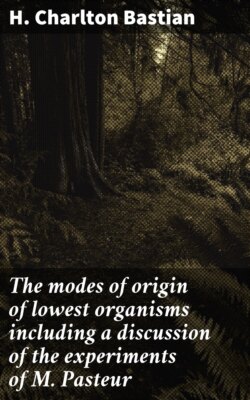The modes of origin of lowest organisms including a discussion of the experiments of M. Pasteur

Реклама. ООО «ЛитРес», ИНН: 7719571260.
Оглавление
H. Charlton Bastian. The modes of origin of lowest organisms including a discussion of the experiments of M. Pasteur
The modes of origin of lowest organisms including a discussion of the experiments of M. Pasteur
Table of Contents
PREFACE
THE MODES OF ORIGIN. OF. LOWEST ORGANISMS
I. Homogenetic Mode of Origin of Bacteria and Torulæ
2. Heterogenetic Mode of Origin of Bacteria and of Torulæ
3. Origin of Bacteria and of Torulæ by Archebiosis
Limits of ‘Vital Resistance’ to Heat displayed by Bacteria and Torulæ
Extent to which boiled Fermentable Fluids may be preserved in Vessels with Bent Necks, or in those whose Necks are guarded by a Plug of Cotton-Wool
COMPARATIVE EXPERIMENTS
First Set of Experiments (I.–XV.)
a. Fluid exposed to Air in a Flask with a short Open Neck
b. Fluid in contact with Ordinary Air and its Particles; Neck of Flask Sealed after the Fluid had become Cold
c. Fluid in a Flask with a Neck two feet long, and having Eight acute Flexures
d. Fluid in a Flask having a Neck two feet long, bent at right angles shortly above the bulb, and provided with a firm Plug of Cotton-Wool twelve inches in length
e. Fluid (in vacuo) in a Flask, the Neck of which was hermetically Sealed by means of the Blowpipe Flame during Ebullition
Second Set of Experiments (XVI.–XXI.)
b. Fluid in contact with Ordinary Air and its Particles; Neck of Flask Sealed after the Fluid had become Cold
c. Fluid in a Bent Neck Flask, having Eight acute Flexures
e. Fluid (in vacuo) in a Flask which had been Sealed during Ebullition
Third Set of Experiments (XXII.–XXX.)
a. Fluid exposed to Air in a Flask with a short Open Neck
b. Fluid in contact with Ordinary Air and its Particles; Neck of Flask Sealed after the Fluid had become Cold
c. Fluid in a Bent Neck Flask, having Eight acute Flexures
e. Fluid (in vacuo) in a Flask, Sealed during Ebullition
Fourth Set of Experiments (XXXI.–XXXVII.)
b. Fluid in contact with ordinary Air and its Particles; Flask Sealed after the Fluid had become Cold
c. Fluid in a Bent-Neck Flask, having Eight acute Flexures
e. Fluid (in vacuo) in a Flask which had been Sealed during Ebullition
Fifth Set of Experiments (XXXVIII.–XLVII.)
Fluids not boiled, but half-filling hermetically Sealed Flasks, containing Ordinary Air
Fluids boiled for five minutes, and half-filling hermetically Sealed Flasks containing Ordinary Air
Fluids (in vacuo)—boiled for five minutes, and Flasks Sealed during Ebullition
Sixth Set of Experiments (XLVIII.–LXV.)
Ammoniacal Solutions, unboiled, and exposed to Ordinary Air in a Corked Bottle.70 (Temp. 60°–65° F.)
Ammoniacal Solutions, unboiled, and exposed to Air in a Corked Bottle, after Inoculation with a Drop of Fluid containing living Bacteria and Torulæ. (Temp. 60°–65° F.)
Ammoniacal Solutions (in vacuo) in Flasks which were hermetically Sealed during Ebullition of their Fluids at a Temperature of 90° F.72 (Subsequently exposed in water-bath to a Temperature of 75°–85° F.)
Ammoniacal Solutions boiled (at 212° F.), and exposed to Air in Flasks whose Open Necks were only loosely covered with Paper Caps: subsequent Inoculation. (Temp. 75°–85° F.)
Solutions of Ammonic Tartrate and Sodic Phosphate were heated, in their respective Flasks, for Fifteen Minutes to the Temperatures mentioned below. The Necks of the Flasks were afterwards loosely covered with Paper Caps, whilst the Bulbs were immersed in a Water-Bath kept at a Temperature of 75°–85° F
Interpretation of the Experiments: Conclusions as to the Cause of Fermentation, and as to the Occurrence ofArchebiosis
SECTION I
HISTORY, BIOGRAPHY, and TRAVELS
SECTION II
POETRY AND BELLES LETTRES
THE GLOBE LIBRARY
MACMILLAN’S
GOLDEN TREASURY SERIES
Footnote
Отрывок из книги
H. Charlton Bastian
Published by Good Press, 2021
.....
Now, as a matter of fact, worthy of arresting our attention, we do find that some Bacteria are capable of growing into Leptothrix, whilst this is able to develop continuously into a fungus; just as we also know that some Torulæ are capable of growing into other fungi.
Should it be established, therefore, that Bacteria and Torulæ are capable of arising de novo, the facts concerning their mutability are harmonious enough with theoretical indications.
.....